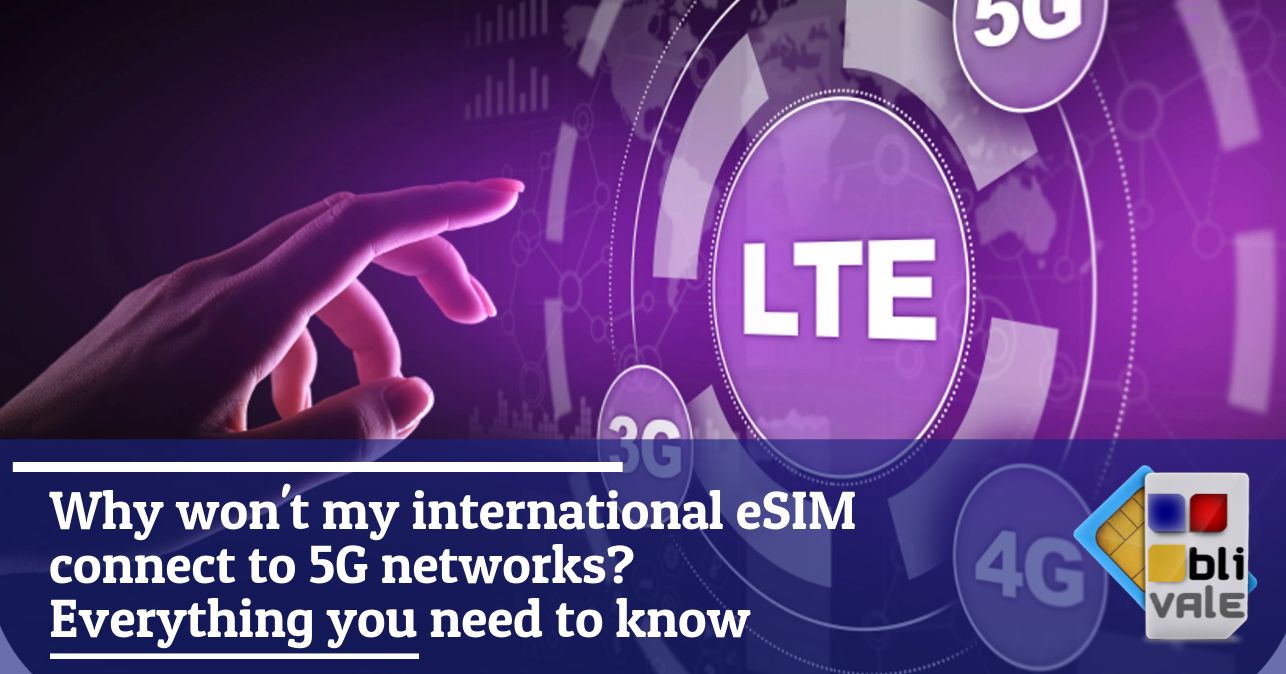If you are reading this article, you are probably in the frustrating situation of having purchased an international eSIM with the promise of 5G coverage, but your device insists on connecting only to 4G or even 3G networks. You are not alone in this experience, and more importantly, it is not your fault.
The truth is that the world of international mobile telecommunications is more complex than the commercial descriptions of eSIMs suggest. Behind those promising words "5G included" lies a reality made up of technical, geographical and commercial variables that are often not adequately communicated to users.
The Promise Game: When Marketing Meets Technical Reality
When we browse the catalogs of international eSIM providers , we often come across descriptions that seem too good to be true: " Guaranteed 5G connection ", " Ultra-fast speeds everywhere ", " Global 5G coverage ". But the reality is quite different.
The "5G washing" strategy
Many virtual network operators (MVNOs) and eSIM providers are adopting a marketing strategy that we could call "5G washing". In the generalized descriptions of their eSIMs, they prefer to highlight only 5G compatibility , even when they know perfectly well that in many destinations 5G is not available or is limited to very specific areas.
This commercial choice, although understandable from a marketing point of view, can create unrealistic expectations in users who expect to always navigate at the maximum possible speed.
The most transparent providers: an honest approach
Fortunately, there are also more conscientious providers that take a more transparent approach. These operators include the full wording "3G/4G/LTE/5G" in their descriptions, clearly informing customers that in the chosen destinations they may find areas where 5G is not yet available, where 3G and 4G/LTE technologies still predominate .
This approach, while less commercially appealing, is definitely more honest and allows travellers to have realistic expectations about the quality of the connection they will find.
Factors That Affect Your eSIM's 5G Connectivity
1. Device Compatibility
Before pointing the finger at the provider, it is essential to check whether your smartphone actually supports 5G . Not all devices are compatible with the 5G frequencies used in every country, and this can be the first obstacle to connecting.
2. Real local coverage
Local 5G coverage is highly variable. Even in technologically advanced countries, 5G may only be available in major urban centers, leaving large rural or peripheral areas covered only by 4G or 3G networks.
3. Roaming agreements
Your eSIM provider may not have 5G roaming agreements with all local carriers. In this case, even if 5G is available in the area, your eSIM may not be able to access it.
4. Technical limitations of the eSIM
Some eSIMs may have technical limitations that prevent access to the most advanced 5G frequencies, forcing the device to fall back on older technologies.
If you are thinking of taking a trip alone or with friends or for work, do not forget the importance of staying connected wherever you are. For unlimited Internet connection, contact BLIVALE where you can get unlimited Internet according to the destinations:
For unlimited plans like data BLIVALE guarantees free roaming anywhere in the world, no additional or hidden costs. Don't let the lack of connection stop you; get ready to explore the world with freedom and spontaneity.
The Global 5G State of Play: Where We Really Are in 2025
Global Overview of 5G Deployment
North America is projected to have the highest 5G adoption rate of any global region in 2030, at 90 percent, followed by Greater China at 88 percent. However, this forecast tells us a lot about the current situation: we are still far from uniform global coverage.
The countries with the most 5G networks are, by a large margin, China and the United States, with around 300 cities where 5G is available. This data highlights how 5G deployment is still very concentrated in specific geographic areas.
The European reality: a heterogeneous panorama
Europe presents a particularly interesting picture. The Nordics are leading the race to move away from legacy technologies, along with the Netherlands, while many Western European markets, such as France, Germany, the UK and Austria, are following suit.
However, Europeans are still highly dependent on 2G and 3G mobile services, with European mobile users spending an average of 3.9% of their time connected to 3G networks. This means that even in Europe, one of the most technologically advanced regions, legacy networks still play a major role.
Most popular tourist destinations: what kind of connection to expect
United States
As of January 2024, the mobile operator with the most widespread 5G coverage in the United States was T-Mobile, with nearly 54 percent of the country. Despite this, nearly half of the U.S. territory is still not covered by 5G, requiring a fallback to 4G/LTE networks.
Asia-Pacific
South Korea is the country that implemented the first 5G network and is expected to remain in the lead in terms of technology penetration. By 2025, nearly 60 percent of mobile subscriptions in South Korea are expected to be for 5G networks.
Europe
The European situation varies dramatically from country to country. While the Nordic countries are rapidly moving away from legacy technologies, many popular tourist destinations in Southern and Eastern Europe still maintain a strong reliance on 3G and 4G networks.
Where you still find 3G and 4G: the map of reality
Africa: The Continent of Transition
At least 95 percent of the population in all global regions except Africa was covered by at least one 3G mobile network in 2023. This highlights how Africa remains the region most likely to face limitations in advanced mobile connectivity.
Developing countries
Many developing countries, despite having 4G infrastructure in major cities, still have large areas covered only by 3G networks. This is especially true for emerging tourist destinations in South America, Central Asia and parts of Eastern Europe.
Rural and remote areas
Even in the most advanced countries, rural and remote areas often still rely on 3G and 4G technologies. If your travels take you outside of major urban centers, there is a good chance that your eSIM will connect to pre-5G networks.
Decommissioning Legacy Networks: A Step-by-Step Process
3G divestment schedule
Countries that will be phasing out 3G in 2023 include Denmark, Slovakia, Greece, Hungary and Sweden. However, this phasing out process is not uniform and many countries are still keeping their 3G networks active to ensure continuity of service in areas less covered by 4G and 5G.
The Resistance of 2G
The global leap to 4G and 5G would cut off phone access for millions of vulnerable people. This explains why many countries are treading carefully in phasing out legacy technologies.
How to Check and Optimize Your eSIM Connection
Preliminary checks
Check device compatibility : Make sure your smartphone supports the 5G bands used in the destination country.
Check your network settings : Make sure your device is set to automatically search for the best available network.
Update your software : Keep your device's operating system and carrier settings up to date.
What to do if 5G doesn't connect
Restart your device : Often a simple restart can fix connection issues.
Turn Airplane Mode off and back on : This forces the device to search for available networks again.
Manually check networks : In your phone settings, manually search for available networks and select the one with the strongest signal.
Contact Support : If problems persist, contact your eSIM provider's technical support.
Advanced settings to optimize your connection
Preferred Network Mode : Set your device to "5G/4G/3G Auto" to ensure the best connection available
Data roaming : Make sure data roaming is active and correctly configured.
APN settings : Make sure the APN settings provided by your provider are entered correctly
The Future of eSIMs and Global 5G
Short-term outlook
Within the next three years, 5G could account for up to 1.4 billion connections by 2025. By then, 5G networks will likely cover a third of the world’s population. This prediction is encouraging, but it also highlights that two-thirds of the world’s population will continue to rely on older technologies.
The Evolution of the eSIM Market
The international eSIM market is rapidly evolving towards greater transparency. Providers are starting to provide more detailed information on actual coverage, also driven by the demands of more informed consumers.
Practical advice for the conscious traveler
Before leaving
Find local coverage : Before purchasing an eSIM, check the actual 5G coverage in your destination.
Read reviews : Check out the experiences of other travellers who have used eSIM in the same destination
Prepare alternatives : Consider purchasing multiple eSIMs from different providers to have backup options.
During the journey
Be patient with your connection : 5G may not be available everywhere, but a good 4G connection is often more than enough for most activities.
Monitor your usage : Slower networks may tempt you to use more data to compensate for the reduced speed.
Experiment with locations : Sometimes moving a few meters can make a difference in signal quality.
Conclusions: Realistic expectations for a better experience
Global 5G connectivity is still a work in progress, not a reality. As international travelers and eSIM users, we need to develop realistic expectations based on the current state of global infrastructure.
The problem of your eSIM not connecting to 5G is often not a defect in the service, but the result of a complex combination of factors: limited local coverage, device compatibility, roaming agreements and, unfortunately, sometimes misleading marketing strategies.
The key to a satisfying experience is informed preparation : carefully researching your destination, choosing transparent providers, and maintaining realistic expectations. Remember that a good 4G/LTE connection is often more than sufficient for most travel connectivity needs.
The future will certainly bring us more widespread and uniform 5G coverage, but for now, patience and understanding the real situation remain the best traveling companions for those using international eSIMs.









